

Live At-Sea Broadcasts |
|
Broadcast Schedule:
|
|
| The following scientists have participated in broadcasts from the ships at sea while conducting their oceanographic research: | |
|
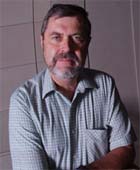 |
Chief Scientist Dr. Arthur Baggeroer, Ford Professor of Engineering at MIT, broadcast live from the R/V Revelle just off the coast of Kaui, Hawaii to Mrs. Brice's 6th period class. He discussed his work as part of the ATOC program with the students. Dr. Baggeroer explained that they were using two ships for this experiment, the Revelle and the Melville. The Melville acted as the transmitter and the Revelle as the receiver. Sound sources already in place in the ocean were also used. The experiments were based on the concept that sound travels faster with increasing temperature or increasing pressure in the sea, and that by using sound "you can take the temperature of the ocean". The basic idea of ATOC (Acoustic Thermometry of Ocean Climate) is simple; sound travels faster in warm water than in cold water. The travel time is a direct measure of the average temperature between the source and the receiver. More information about the ATOC project can be found at: http://www.atoc.ucsd.edu The students had already done several activities on Sound in the Ocean to prepare for the broadcast. Some of their questions for Dr. Baggeroer included: "What are you studying out there?" "How long have you studied oceanography?" "Why did you decide to study oceanography?" "Where did you go to school?" "What is your degree in?" and "What is it like on the ship?" |
|
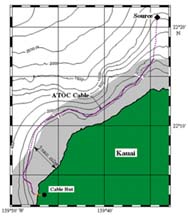 |
The chart at the left shows the acoustic source off the coast of Kauai that allows scientists to study both climate and marine mammal responses to the sounds generated. At the right the students are enjoying their first live at-sea broadcast with Dr. Arthur Baggeroer as Dr. Robert Knox attends. |
 |
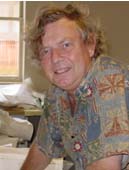 |
Dr. Peter Lonsdale, Ph.D. October 13, 2004 |
|
The students in Mrs. Brice's 6th period class participated in their second live at-sea broadcast with Dr. Peter Lonsdale from the R/V Roger Revelle on October 13, 2004. Dr. Lonsdale's main interests are in structural geomorphology of plate boundary zones, tectonic history of the Pacific basin and the geology of seamounts and guyots. During his research cruise, he was using the multibeam on the Revelle to map geophysical features on the bottom of the ocean during a transit between Hawaii and San Diego. The students have been studying the speed of sound in the ocean and doing activities modeling how to use sound to map the bottom of the ocean (see their lab journals for their bathymetric charts). They had many questions for Dr. Lonsdale about how he uses the multibeam in his research. As Dr. Lonsdale was talking to the students, the map plotter was visible behind him as he was discovering and mapping a new fracture zone during the broadcast (see the top right photo). When he told the students that his main interests were in geology of the ocean floor, the students wanted to know why it wouldn't be easier for him to study geology on land. Dr. Lonsdale responded that by looking at the ocean floor he sees features that have not been changed by weathering and erosion as on land, and that gives him a better idea of what forces controlled the formation of the features on the bottom of the ocean. In his research on the sea floor, Dr. Lonsdale also utilized a dredge (see the bottom right photo). Learn more about Dr. Peter Lonsdale and his work at the Marine Physical Laboratory at http://www-mpl.ucsd.edu. photos by Chief Engineer Paul Mauricio |
Dr. Measures talking to the students via satellite while a new fracture zone is mapped behind him. |
|
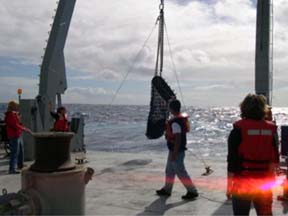 |
||
Dr. Chris Measures, Ph.D. December 2004 |
Dr. Dave Nelson, Ph.D. December 2004 |
Debra Brice January/February 2005 |
|
|
Dr. Elizabeth Sikes, Ph.D. March 7, 2005 |
The live broadcasts to Mrs. Brice's classroom from aboard the Revelle were culminated for the 2004-2005 school year with Dr. Elizabeth Sikes as she conducted ocean bottom coring research in the South Pacific off the coast of New Zealand. Her research interests are in the field of paleoceanography and paleoclimate. She has worked with sea surface temperature records and modern samples to improve paleo-sea temperature estimates. She has also studied deep ocean circulation using carbon 14 as a tracer for climate-driven circulation changes. Detailed cruise logs of her research trip aboard the Revelle can be viewed at http://marine.rutgers.edu/~sikes/revelle-blog.htm. Dr. Sikes professional information web page can be viewed at http://marine.rutgers.edu/~sikes/. |
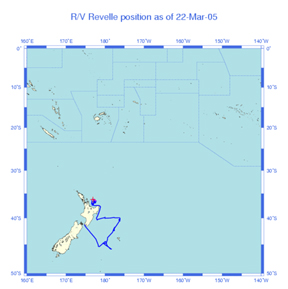 |
|
Raising the corer from the bottom of rough seas |
The corer on deck |
|
Slicing the core |
Core sliced in half |
Core Layers |